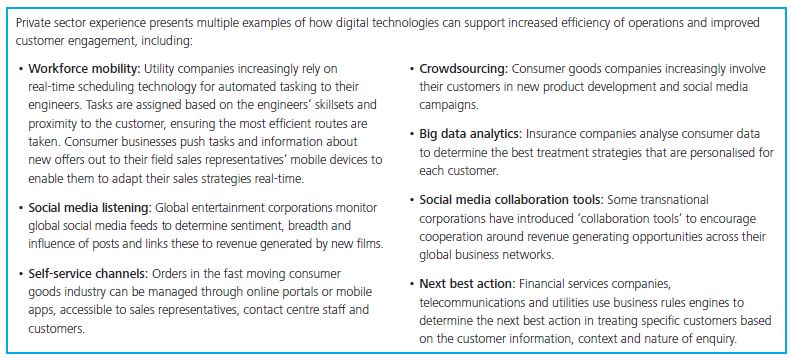Foreword
The founding principles of policing, as defined by Sir Robert Peel, are as true and necessary today as they ever were. But the realities and pressures of the 21st century call for a new, digital way of operating.
Today the UK police service is at a tipping point. Police forces face increasing public expectations and scrutiny, changes in crime profile and increasing non-crime- related demand. They must deliver improved services despite facing the deepest budget cuts in a generation, as the austerity measures are likely to continue until at least 2019. There is increasing pressure to deliver more – for less. As both criminal activity and interaction with citizens move increasingly online, the traditional model of providing a physical presence in order to deter crime and reassure communities is no longer enough on its own, and is costly too. Police forces must learn to harness digital technology if they are to deliver a service that is fit for purpose in the 21st century.
Digital technology has the potential to transform the way policing is delivered – taking police officers away from police stations and bringing them closer to communities and crime spots. However, in order to truly benefit from these new digital capabilities a holistic approach is required – starting with core processes and behaviours. In realising the potential of digital technologies police forces can learn from private sector organisations that share similar characteristics and challenges: a mobile workforce; the need to process and analyse vast amounts of data to make decisions, and operationalise those decisions quickly; the need to engage with customers via multiple channels; the ability to respond to customers' desire for self-service.
In this paper we present the concept of digital policing across the lifecycle of crime prevention, response and investigation. We then look at how forces can learn from the successes and failures of the private sector to make this concept a reality. Over the past decade Deloitte has helped many consumer-facing organisations embed digital ways of operating, and we have summarised the common pitfalls and success factors here.
Successfully adopting digital technologies requires a holistic view of policing operations. This paper provides practical recommendations in five key steps. It looks at processes, information, systems, devices and location.
Our future digital police service will not only be more efficient in fighting crime – but much more powerful too.
James Taylor
Partner
Traditional policing objectives have not changed, but the current ways of delivering services are becoming outdated
Policing principles have seen little change since 1829. As outlined in the 'National Policing Vision 2016' by the College of Policing, forces still exist primarily to prevent crime and protect the public.
Originally, police forces relied heavily on the decision- making abilities of individual officers and their physical proximity to crime hotspots.
The technology revolution of the 1970s and 1980s enabled a more informed decision-making process, based on the information held and analysed in computer systems. But it also meant officers spending large amounts of time at police stations, where computers took them away from where their services were required most.
Today digital technologies make it possible for police officers to be where crime is happening, when it is happening – even in virtual locations.
Their actions can then be directed by powerful, instantly available insights, based on the analysis of vast amounts of data. The location and time of criminal activity can now be identified – or even predicted – faster. So officers can return to the streets, and, thanks to digital technology, be better equipped with information to support their decisions.
However, policing is still reliant on 'old-school' infrastructure and processes: extensive networks of police stations, manual processing of intelligence, face- to-face briefings, paper-based case files and forensic capabilities focussed on physical evidence.
Without deploying digital technology, the task of fighting crime and protecting citizens becomes almost impossibly tough in a world where citizens and criminals alike are increasingly digitally savvy. Failure to adopt digital technologies also restricts the ability of police forces to operate effectively within the ever more constrained budgets driven by the Comprehensive Spending Reviews.
The importance of digital has also been highlighted by Her Majesty's Inspectorate of Constabulary's ongoing inspections into how forces are dealing with cybercrime and maximising the opportunities offered by digital technologies.
Today digital technologies make it possible for police officers to be where crime is happening, when it is happening – even in virtual locations.
Police forces can transform the delivery of their services by applying technologies that have been tried and tested in the private sector
Private sector enterprises use digital technologies to maximise the time their workforces spend on delivering core services and meeting customer needs. The services of consumer businesses have been transformed by predictive analytics, digital customer interaction channels, dynamic scheduling of field forces, mobile communications, and remote access to core information systems.
The four lenses of Digital Policing
If applied to policing, digital technologies can push the boundaries of what is possible across four lenses:

Applying digital technologies across these four lenses can enable police forces to use their resources more intelligently, target criminal activity more proactively, and deliver a faster, more targeted response through real-time information-sharing and effective decision-making.
Experience from the Private Sector

The content of this article is intended to provide a general guide to the subject matter. Specialist advice should be sought about your specific circumstances.
